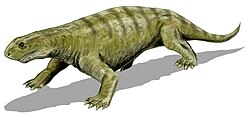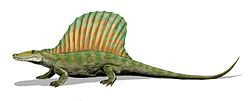| Vaughnictis Temporal range: Early Permian | |
|---|---|
 | |
| Skull of holotype | |
 | |
| Life Restoration | |
| Scientific classification | |
| Kingdom: | Animalia |
| Phylum: | Chordata |
| Clade: | Synapsida |
| Clade: | † Caseasauria |
| Family: | † Eothyrididae |
| Genus: | † Vaughnictis Brocklehurst et al., 2016 |
| Species: | †V. smithae |
| Binomial name | |
| †Vaughnictis smithae (Lewis & Vaughn, 1965) | |
Vaughnictis is an extinct genus of synapsid from the Early Permian of Colorado in the family Eothyrididae. It was originally assigned to the genus Mycterosaurus before it was assigned to the new genus Vaughnictis. It is known from a partial skull, hindlimb, and a few ribs. It is closely related to Eothyris . [1]





